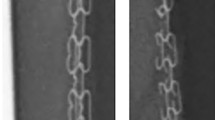Abstract
Background
Little evidence is available on the choice of linear staple reloads in laparoscopic sleeve gastrectomy (LSG). Previous literature recommends matching closed staple height (CSH) to tissue-thickness (TT) to avoid ischemia. Our objective was to examine feasibility and safety of “tight” hemostatic (CSH/TT <1) stapling and map the entire gastric wall TT in LSG patients.
Methods
Prospectively collected outcomes on 202 consecutive patients who underwent LSG with tight order of staples (Ethicon Endosurgery) in this order: pre-pylorus—black (CSH = 2.3 mm), antrum—green (CSH = 2.0 mm), antrum/body—blue (CSH = 1.5 mm), and white (CSH = 1.0 mm) on the body and fundus. Measurements of entire gastric wall TT were made on the first 100 patients’ gastric specimens with an electronic-dogmatic indicator.
Results
Study included 147 females and 55 males with a mean age of 41.5 ± 11.9 years and body mass index of 41.5 ± 3.8 kg/m2. Gastric wall measurements revealed mean CSH/TT ratio <1, decreasing from 0.7 ± 0.1 at pre-pylorus to 0.5 ± 0.1 at the fundus. There were 3.1% mechanical failures, mainly (68%) at pre-pylorus—black reloads. Post-operative bleeding occurred in 5 (2.5%) patients. There were no leaks or clinical evidence of sleeve ischemia. Stepwise regression analysis revealed that body mass index (P < 0.001), hypertension (P < 0.01), and male gender (P < 0.001) were associated with increased gastric TT.
Conclusions
Our study suggests that reloads with CSH/TT <1 in LSG including staples with CSH of 1 mm on body and fundus are safe. The results challenge the concept that tight stapling cause’s ischemia. Since tight reloads are designed to improve hemostasis, their application could have clinical benefit.


Similar content being viewed by others
Abbreviations
- LSG:
-
Laparoscopic sleeve gastrectomy
- TT:
-
Tissue thickness
- CSH:
-
Closed staple height
- BMI:
-
Body mass index
References
Baker RS, Foote J, Kemmeter P, Brady R, Vroegop T, Serveld M. The science of stapling and leaks. Obes Surg. 14 10:1290–8. Jan.
Chekan E, Whelan RL. Surgical stapling device-tissue interactions: what surgeons need to know to improve patient outcomes. Med Devices (Auckl). 2014;7:305–18.
Rawlins L, Rawlins MP, Teel D. Human tissue thickness measurements from excised sleeve gastrectomy specimens. Surg Endosc. 2014;28(3):811–4.
Bellanger DE, Greenway FL. Laparoscopic sleeve gastrectomy, 529 cases without a leak: short-term results and technical considerations. Obes Surg. 2011;21(2):146–50.
Sakran N, Assalia A, Sternberg A, et al. Smaller staple height for circular stapled gastrojejunostomy in laparoscopic gastric bypass: early results in 1,074 morbidly obese patients. Obes Surg. 2011;21(2):238–43.
Huang R, Gagner M. A thickness calibration device is needed to determine staple height and avoid leaks in laparoscopic sleeve gastrectomy. Obes Surg. 2015;25(12):2360–7.
Aurora AR, Khaitan L, Saber AA. Sleeve gastrectomy and the risk of leak: a systematic analysis of 4,888 patients. Surg Endosc. 2012;26(6):1509–15.
Sroka G, Milevski D, Shteinberg D, et al. Minimizing hemorrhagic complications in laparoscopic sleeve gastrectomy—a randomized controlled trial. Obes Surg. 2015;25(9):1577–83.
Bransen J, Gilissen LPL, van Rutte PWJ, et al. Costs of leaks and bleeding after sleeve gastrectomies. Obes Surg. 2015;25(10):1767–71.
Shikora SA, Mahoney CB. Clinical benefit of gastric staple line reinforcement (SLR) in gastrointestinal surgery: a meta-analysis. Obes Surg. 2015;25(7):1133–41.
Zellmer JD, Mathiason MA, Kallies KJ, et al. Is laparoscopic sleeve gastrectomy a lower risk bariatric procedure compared with laparoscopic Roux-en-Y gastric bypass? A meta-analysis. Am J Surg. 2014;208(6):903–10. discussion 909–10
Author information
Authors and Affiliations
Corresponding author
Ethics declarations
Conflict of Interest
The authors declare that they have no conflict of interest.
Ethical Approval
All procedures performed in studies involving human participants were in accordance with the ethical standards of the institutional and/or national research committee and with the 1964 Helsinki Declaration and its later amendments or comparable ethical standards.
Informed Consent
For this type of study, formal consent is not required.
Funding Sources
None.
Additional information
Yasmin Abu-Ghanem and Chanan Meydan had equal contribution to this article.
Rights and permissions
About this article
Cite this article
Abu-Ghanem, Y., Meydan, C., Segev, L. et al. Gastric Wall Thickness and the Choice of Linear Staples in Laparoscopic Sleeve Gastrectomy: Challenging Conventional Concepts. OBES SURG 27, 837–843 (2017). https://doi.org/10.1007/s11695-016-2516-2
Published:
Issue Date:
DOI: https://doi.org/10.1007/s11695-016-2516-2




